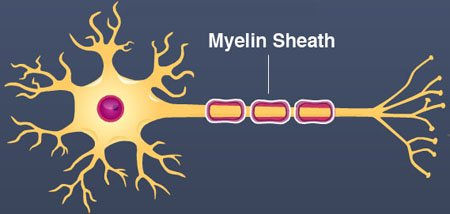The Myelin Sheath and its Role in Neural Transmission
- Med Dreamers
- Aug 24, 2023
- 2 min read
Updated: Sep 16, 2024
The myelin sheath is a vital component of the nervous system, playing a crucial role in enhancing neural transmission efficiency. This research report explores the structure and function of the myelin sheath and its impact on neural transmission. By insulating axons and facilitating saltatory conduction, the myelin sheath accelerates the propagation of action potentials. This acceleration has significant implications for neural communication, influencing the speed and reliability of information transfer throughout the nervous system. Through an analysis of relevant literature, this report presents an overview of the myelin sheath's contributions to neural transmission efficiency. Introduction
The myelin sheath, a fatty substance enveloping axon, is a key determinant of neural transmission efficiency. This insulating layer is formed by specialized cells known as oligodendrocytes in the central nervous system (CNS) and Schwann cells in the peripheral nervous system (PNS). The myelin sheath functions as an electrical insulator, enabling the rapid propagation of action potentials along axons.
Structure and Formation of Myelin Sheath: The myelin sheath is composed of multiple layers of lipid-rich membranes wrapped around axons. These layers are primarily comprised of proteins and lipids, with a high concentration of myelin basic protein (MBP) and lipids such as cholesterol and sphingomyelin. The structure of the myelin sheath consists of periodic gaps known as nodes of Ranvier, where the axonal membrane is exposed.

Impact on Neural Transmission: The myelin sheath's structural organization has a profound impact on neural transmission. The nodes of Ranvier are essential for the saltatory conduction mechanism, whereby action potentials "jump" from one node to another, significantly enhancing conduction speed. This saltatory conduction conserves energy and ensures rapid transmission of information. Contribution to Neural Transmission Efficiency: The myelin sheath's role in enhancing neural transmission efficiency is evident in various neurological disorders. Demyelinating diseases, such as multiple sclerosis, result in disrupted myelin sheaths, leading to slowed or blocked neural transmission. This underscores the critical importance of the myelin sheath in maintaining proper nervous system function. Conclusion: In conclusion, the myelin sheath plays a pivotal role in optimizing neural transmission efficiency. Through its insulation and saltatory conduction mechanism, the myelin sheath accelerates the propagation of action potentials, contributing to rapid and reliable neural communication. Understanding the structure and function of the myelin sheath sheds light on its crucial significance in maintaining the integrity of the nervous system. References: Arancibia-Cárcamo, I. L., & Attwell, D. (2014). Myelination affects the time required for an action potential to propagate between nodes of Ranvier. Frontiers in Cellular Neuroscience, 8, 505. Nave, K. A., & Werner, H. B. (2014). Myelination of the nervous system: mechanisms and functions. Annual Review of Cell and Developmental Biology, 30, 503-533. Salzer, J. L. (2015). Schwann cell myelination. Cold Spring Harbor Perspectives in Biology, 7(8), a020529. Stys, P. K., & Lipton, S. A. (2007). White matter NMDA receptors: an unexpected new therapeutic target?. Trends in Pharmacological Sciences, 28(11), 561-566.




Comments